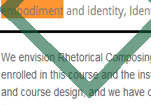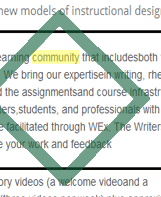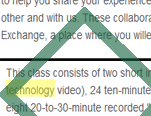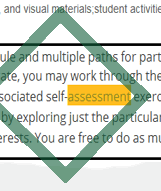Community
 |
||||||||
 |
 |
|||||||
 |
 |
 |
||||||
 |
||||||||
 |
 |
|||||||
 |
||||||||
Critel emphasizes how her research revealed the “performative nature of participation and the messiness of assessment in classrooms” (this collection). Critel’s dissertation, “Investigating The Rhetoric of Student Participation: Uncovering and Historicizing Commonplaces in Composition Studies,” contains a wealth of groundbreaking findings presented in a useful and synthesized way. As she explains succinctly in the “challenges” section, “An ethical statement of participation should include what counts as participation, how information will be collected, and how that assessment will be conveyed to students over the course of the quarter” (194). The requirement to provide guidelines and feedback that inform students of formative assessment methods and definitions as well as summative evaluations, should define best practices. But as Critel discovered, there is little evidence that supports those practices in actual course syllabi. These MOOC syllabi are no different; they presume an ever-expanding community that can somehow form through the wonders of technology, and still be coherent.
Udacity Course: Applied Cryptography
Applied Cryptography, an advanced computer course on Udacity, introduces computer security, without which nothing in contemporary society can operate.
An interesting FAQ titled “What are the rules on collaboration?” appears to have been a standard statement for Udacity courses. It reads: “Collaboration is a great way to learn. You should do it! The key is to use collaboration as a way to enhance learning, not as a way of sharing answers without understanding them” (Evans, "Applied Cryptography Archive"). Even as this statement works to undo traditional conceptions of “cheating” in school, this description operates within the vague idea of participation as self-evident and communities of learners as self-defining and naturally forming. The current posted version of this course indicates the features of a "Student Support Community" and "In-Person Collaboration" but with no description.
[Go to "Technology"]